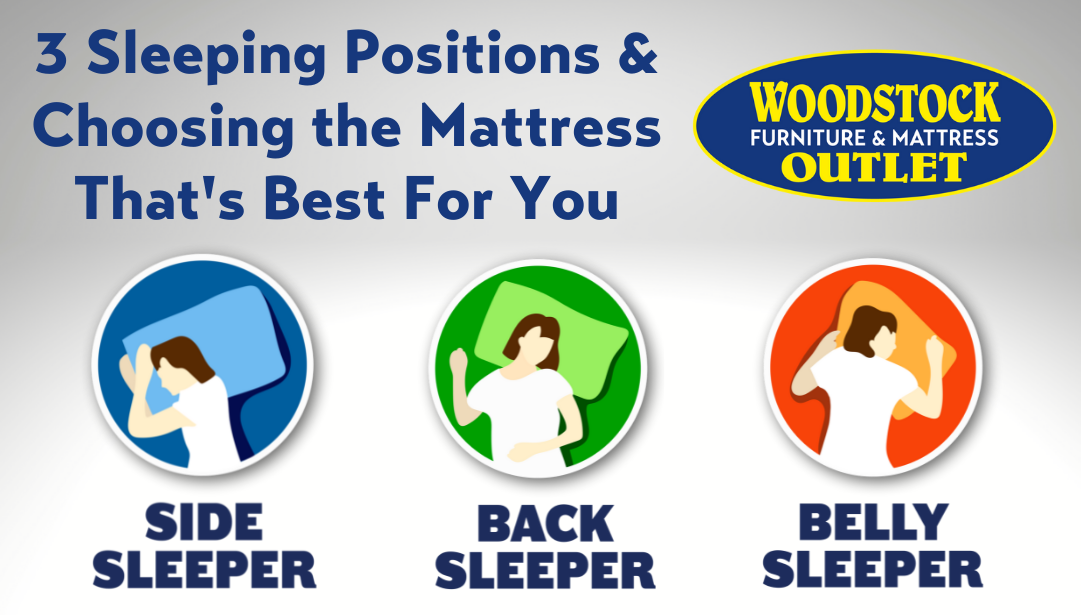Mattress shopping seems so much more complicated than it used to be. There are so many brands and different types of mattresses, it’s so easy to fall victim to the “paralysis of analysis”. It’s enough to make you wonder, “Where do I even begin to start my own mattress search?” Here at Woodstock Furniture & Mattress Outlet, when mattress shoppers ask for our help in choosing the mattress that’s best for them, we often start by asking about their preferred sleeping positions.
By the end of this article, you’ll have an idea of the pros and cons of the different sleep positions and which kind of mattress is best for each. However, keep in mind that each sleeper is different, with their own unique body shape, weight, health history and preferences. That’s why these suggestions are only meant to be a jump off point for your own mattress shopping journey.
So What Are the 3 Sleeping Positions?

Ask anyone how they sleep, and you’re guaranteed to get 3 typical answers — or some combination of them. Starting from most common to least, the 3 sleeping positions are side-sleeping, back-sleeping, and stomach-sleeping. But which is yours?
Let’s get started!
The Side Sleeper
According to the findings of numerous polls and sleep studies, the majority of people sleep on their sides. This figure is usually reported to be between 60 and 75 percent.
Additionally, most doctors and sleep researchers consider side-sleeping to be the healthiest option as there are many associated health benefits. This sleep position is great for spinal alignment and joint health, but also for preventing sleep disorders like snoring, sleep apnea, and GERD.
If you are a side sleeper, your best place to start would be with a soft or medium mattress. That’s because too firm of a mattress will not contour to your hips or shoulders and will eventually throw your spine out of alignment. Also consider foam or hybrid mattresses, because they are designed specifically to adapt to your body’s shape and cradle pressure points like your shoulders and hips.
The Back Sleeper
Back-sleeping is the second most common of the major sleeping positions. This position has its share of benefits as well, although there are also a few drawbacks.
If you’re someone who suffers from chronic back pain, the benefits of back-sleeping likely outweigh the cons. Sleeping on your back can eliminate many pressure points and is great for spinal alignment. However, if you suffer from sleep apnea, snoring, or even acid reflux, back-sleeping may make these conditions worse.
As a back sleeper, it’s usually best to try a mattress somewhere between firm and medium. Too soft of a mattress can result in back and neck pain because the heaviest part of your body (your core) will sink too far into the mattress.
For this reason, it is important for back sleepers to have a supportive mattress – whether innerspring, hybrid or foam. You should be looking for a mattress that is responsive, and not one that gives you too much of a “sinking feeling”.
The Stomach Sleeper
Stomach sleepers are far-and-away the rarest type of sleeper – and according to medical experts, that’s a good thing. This is the least recommended of the sleeping positions because the cons of stomach-sleeping usually outweigh the pros.
For instance, while stomach-sleeping can reduce the symptoms associated with GERD, snoring and sleep apnea, it can also cause spine misalignment, neck pain, back pain, and joint and muscle aches. Especially with the wrong mattress. But hey, what can you do? Sometimes you’ve gotta sleep whichever way lets you fall asleep, right?
As for which mattress is best for stomach-sleeping, our advice is similar to back sleepers. That’s because whether you sleep on your back or stomach, your core tends to sink into the mattress more than your head, arms, or legs. Like above, you’ll want to start off by trying firm or medium mattresses that will not let you sink too far into the mattress.
Beyond Sleeping Positions: Continue Your Mattress Buying Journey Below!
Now that you’ve learned about sleeping positions and which mattress comfort level is ideal for each, you’ve got an idea where to start on your mattress buying journey. However, more info is always better! Be sure to check out these other helpful, educational mattress resources below:
- The Big Problem With Mattress Firmness Ratings
- Innerspring vs Hybrid vs Foam Mattress: Understanding the 3 Key Types of Mattresses
Lastly, be sure to check out our 100% free mattress buying guide! We’ve compiled a bunch of our best mattress buying advice in one place, so that you can have everything you need to make an informed mattress decision.











